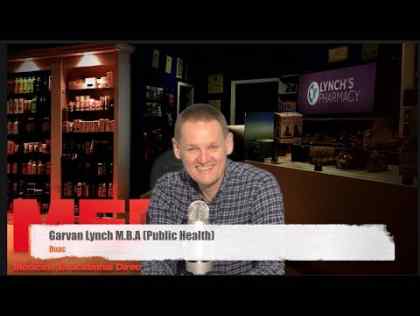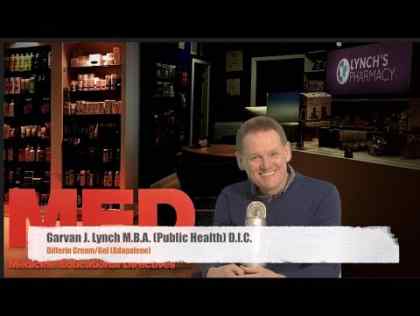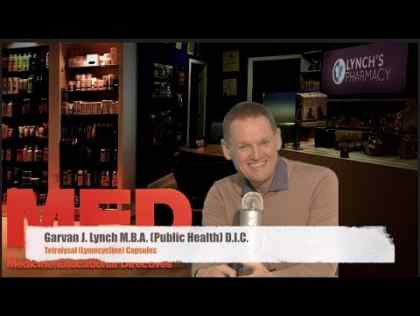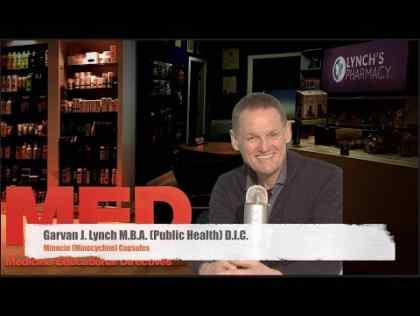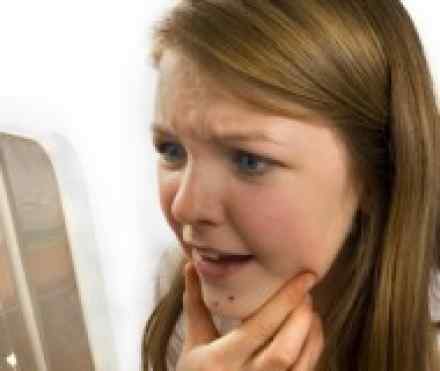
What is acne?
Acne is the common cause of 'spots'. Most people with acne are aged between 12 and 25, but some older and younger people are affected. Acne usually affects the face but may also affect the back, neck, and chest. The severity can range from mild to severe. About 9 in 10 teenagers develop some degree of acne. Often it is mild. However, it is estimated that about 3 in 10 teenagers have acne bad enough to need treatment to prevent scarring. Untreated acne usually lasts about 4-5 years before settling. However, it can last for many years in some cases.
What causes acne?
Understanding normal skin
Small sebaceous glands lie just under the skin surface. These glands make the 'oil' (sebum) that keeps the skin supple and smooth. Tiny pores (holes) on the skin allow the sebum to come onto the skin surface. Hairs also grow through these pores. During the teenage years, you make much more sebum than when you were a child. This is due to the hormone changes of puberty which stimulate the sebaceous glands. As a rule, the more sebum that you make, the more greasy your skin feels, and the worse acne is likely to be. Some people make more sebum than others.
Mild to moderate acne
Blackheads, whiteheads, and small pimples. Some pores become blocked ('plugged'). This is due to the skin at the top of the pores becoming thicker, combined with dead skin cells that are shed into the pores. You can see the 'plugs' that block the top of the pores as tiny spots known as comedones (blackheads and whiteheads). Note: the black of the blackheads is due to skin pigment, and is not dirt as some people think. In many cases, acne does not progress beyond this mild stage.
Some sebum may collect under blocked pores. You can see this as small spots called pimples or papules. In some cases, acne does not progress beyond this mild-to-moderate stage when you can see a number of small pimples, blackheads, and whiteheads.
Moderate to severe acne
Larger spots and inflammation. Trapped sebum is ideal for a bacterium (germ) to live and multiply. Small numbers of this bacterium normally live on the skin, and do no harm. However, if a large number develop in the trapped sebum, the immune system may react and cause inflammation. If inflammation develops, it causes the surrounding skin to become red, and the spots become larger and filled with pus (pustules). In some cases the pustules become even larger and form into small 'nodules' and cysts.
Each inflamed spot will heal eventually. In some cases the area of skin that was inflamed remains discoloured for several months after the inflammation has gone (post-inflammatory hyperpigmentation). This is often more noticeable in darker skinned people. Also, a small pitted scar is commonly left on the skin where there was an inflamed spot. These small scars often do not fade fully and are a marker in older people that they once had inflamed acne spots.
Rare causes of acne
The description above is the cause of almost all cases of acne. Rarely, certain diseases in girls and women may cause acne, or make acne worse. For example, polycystic ovary syndrome, and conditions that cause excess male hormone to be made in the ovary or adrenal gland. These conditions cause other symptoms in addition to acne such as thinning of scalp hair, excess growth of facial or body hair (hirsutes), and other problems. Another rare cause of acne is exposure to halogenated hydrocarbons (chemicals that occur in some work places).
What makes acne worse?
-
The progestogen-only contraceptive pill may make acne worse.
-
In women, the hormone changes around the monthly period may cause a flare-up of spots.
-
Thick or greasy make-up may, possibly, make acne worse. However, most make-up does not affect acne. You can use make-up to cover some mild spots. Non-comedogenic or oil-free products are most helpful for acne-prone skin types.
-
Picking and squeezing the spots may cause further inflammation and scarring.
-
Sweating heavily or humid conditions may make acne worse. For example, doing regular hot work in kitchens. The extra sweat possibly contributes to blocking pores.
-
Spots may develop under tight clothes. For example, under headbands, tight bra straps, tight collars, etc. This may be due to increased sweating and friction under tight clothing.
-
Some drugs can make acne worse. For example, phenytoin which some people take for epilepsy, and steroid creams and ointments that are used for eczema. Do not stop a prescribed drug if you suspect it is making your acne worse, but tell your doctor. An alternative may be an option.
-
Anabolic steroids (which some body-builders take illegally) can make acne worse.
Some myths about acne
-
Acne is not caused by poor hygiene. In fact, excessive washing may make it worse. Diet has little or no effect on acne. For example, there is no evidence that chocolate, sweets, or fatty foods cause acne or make acne worse.
-
Stress does not cause acne. Acne is not just a simple skin infection. The cause is a complex interaction of changing hormones, sebum, overgrowth of a normally harmless bacteria, inflammation. You cannot 'catch' acne - it is not contagious.
-
Acne cannot be cured by drinking lots of water.There is no evidence to say that sunbathing or sunbeds will help to clear acne.
-
Some people believe that acne cannot be helped by medical treatment. This is not true. Treatments usually work well if used correctly.
Treatments and drugs
Acne treatments work by reducing oil production, speeding up skin cell turnover, fighting bacterial infection, reducing the inflammation or doing all four. With most prescription acne treatments, you may not see results for four to eight weeks, and your skin may get worse before it gets better.
Your doctor or dermatologist may recommend a prescription medication you apply to your skin (topical medication) or take by mouth (oral medication). Oral prescription medications for acne should not be used during pregnancy, especially during the first trimester.
Types of acne treatments:
Over-the-counter topical treatments.
Acne lotions may dry up the oil, kill bacteria and promote sloughing of dead skin cells. Over-the-counter (OTC) lotions are generally mild and contain benzoyl peroxide, sulfur, resorcinol, salicylic acid or lactic acid as their active ingredient. These products can be helpful for very mild acne. OTC acne medications may cause initial side effects — such as skin irritation, dryness and flaking — that often improve after the first month of therapy.
Topical treatments available by prescription.
If your acne doesn't respond to OTC treatments, you may want to see a doctor or dermatologist to get a stronger prescription lotion. Tretinoin ( Retin-A), adapalene (Differin) are examples of topical prescription products derived from vitamin A. They work by promoting cell turnover and preventing plugging of the hair follicles. A number of topical antibiotics also are available. They work by killing excess skin bacteria. Often, a combination of such products is required to achieve optimal results. A number of benzoyl peroxide and antibiotic combination medications are available, including different dose combinations of benzoyl peroxide and clindamycin (Duac) and benzoyl peroxide and erythromycin (Benzamycin). Prescription topical treatments for acne may cause skin side effects, such as stinging, burning, redness or peeling. Your doctor may recommend steps to minimize these side effects, including using a gradually increased dose, washing off the medication after a short application or switching to another medication.
Antiobiotics
For moderate to severe acne, you may need a short course of prescription oral antibiotics to reduce bacteria and fight inflammation. Since oral antibiotics were first used to treat acne, antibiotic resistance has increased significantly in people with acne. For this reason, your doctor likely will recommend tapering off these medications as soon as your symptoms begin to improve, or as soon as it becomes clear the drugs aren't helping — usually, within three to four months. In most cases, you'll use topical medications and oral antibiotics together. Studies have found that using topical benzoyl peroxide along with oral antibiotics may reduce the risk of developing antibiotic resistance. Antibiotics may cause side effects such as an upset stomach, dizziness or skin discoloration. These drugs also increase your skin's sun sensitivity and may also reduce the effectiveness of oral contraceptives.
Isotretinoin.
For deep cysts, antibiotics may not be enough. Isotretinoin (Roaccutane) is a powerful medication available for scarring cystic acne or acne that doesn't respond to other treatments. This medicine is reserved for the most severe forms of acne. It's very effective, but people who take it need close monitoring by a dermatologist because of the possibility of severe side effects. Isotretinoin is associated with severe birth defects, so it can't be safely taken by pregnant women or women who may become pregnant during the course of treatment or within several weeks of concluding treatment. Isotretinoin commonly causes side effects such as dry eyes, mouth, lips, nose and skin, as well as itching, nosebleeds, muscle aches, sun sensitivity and poor night vision. The drug may also increase the levels of triglycerides and cholesterol in the blood and may increase Liver enzyme levels.
Oral contraceptives.
Oral contraceptives, including a combination of norgestimate and ethinyl estradiol, can improve acne in women. However, oral contraceptives may cause other side effects — such as headaches, breast tenderness, nausea and depression — that you'll want to discuss with your doctor. The most serious potential complication is a slightly increased risk of heart disease, high blood pressure and blood clots.
Laser and light therapy.
Laser and light based therapies reach the deeper layers of skin without harming the skin's surface. Laser treatment is thought to damage the oil (sebaceous) glands, causing them to produce less oil. Light therapy targets the bacteria that cause acne inflammation. These therapies can also improve skin texture and lessen the appearance of scars. More research is needed to understand the most effective use of light and laser therapies in acne treatment, and experts currently recommend these approaches as stand-alone therapy only in people who can't tolerate approved acne medications. These therapies may be uncomfortable and may cause temporary skin problems that mimic a severe sunburn.
Cosmetic procedures.
Chemical peels and microdermabrasion may be helpful in controlling acne. These cosmetic procedures — which have traditionally been used to lessen the appearance of fine lines, sun damage and minor facial scars — are most effective when used in combination with other acne treatments. They may cause temporary, severe redness, scaling and blistering, and long-term discoloration of the skin.
Acne scar treatment
Doctors may be able to use certain procedures to diminish scars left by acne. These include fillers, dermabrasion, intense light therapy and laser resurfacing.
-
Soft tissue fillers. Collagen or fat can be injected under the skin and into scars to fill out or stretch the skin, making the scars less noticeable. Results from this acne scar treatment are temporary, so you need to repeat the injections periodically.
-
Dermabrasion. Usually reserved for more severe scarring, dermabrasion involves removing the top layer of skin with a rapidly rotating wire brush. Surface scars may be completely removed, and deeper acne scars may appear less noticeable. Dermabrasion may cause pigmentation changes for people with darker skin.
-
Microdermabrasion. This newer acne scar treatment involves a hand-held device that blows crystals onto skin. These crystals gently abrade or "polish" the skin's surface. Then, a vacuum tube removes the crystals and skin cells. Because just the surface cells are removed, the skin isn't damaged. However, results are subtle and scars may still be noticeable, even after several sessions.
-
Laser, light source and radiofrequency treatments. In laser resurfacing, a laser beam destroys the outer layer of skin (epidermis) and heats the underlying skin (dermis). As the wound heals, new skin forms. Less intense lasers (nonablative lasers), pulsed light sources and radiofrequency devices don't injure the epidermis. These treatments heat the dermis and cause new skin formation. After several treatments, acne scars may appear less noticeable. This means shorter recovery times, but treatment typically needs to be repeated more often and results are subtle.
-
Skin surgery. A minor procedure (punch excision) cuts out individual acne scars. Stitches or a skin graft repairs the hole left at the scar site.
Living with Acne
You can avoid or control most acne with good basic skin care and the following self-care techniques:
-
Wash problem areas with a gentle cleanser. Products such as facial scrubs, astringents and masks generally aren't recommended because they tend to irritate skin, which can worsen acne. Excessive washing and scrubbing also can irritate skin. If you tend to develop acne around your hairline, shampoo your hair frequently.
-
Try over-the-counter acne lotion to dry excess oil and promote peeling. Look for products containing benzoyl peroxide or salicylic acid as the active ingredient.
-
Avoid irritants. You may want to avoid oily or greasy cosmetics, sunscreens, hairstyling products or acne concealers. Use products labeled "water-based" or "noncomedogenic." For some people, the sun worsens acne. Additionally, some acne medications can make you more susceptible to the sun's rays. Check with your doctor to see if your medication is one of these, and if so, stay out of the sun as much as possible and anytime you have to be in the sun, use sunscreen that doesn't clog your pores.
-
Watch what touches your face. Keep your hair clean and off your face. Also avoid resting your hands or objects, such as telephone receivers, on your face. Tight clothing or hats also can pose a problem, especially if you'll be sweating. Sweat, dirt and oils can contribute to acne.
-
Don't pick or squeeze blemishes. Picking or squeezing can cause infection or scarring. If you need aggressive treatment, see your doctor or dermatologist.
References:
https://en.wikipedia.org/wiki/Acne_vulgaris
http://www.medicalnewstoday.com/articles/107146.php
http://www.nhs.uk/Conditions/Acne/Pages/Introduction.aspx
http://www.mayoclinic.com/health/acne/DS00169
http://www.webmd.com/skin-problems-and-treatments/acne/default.htm
http://www.acne.org
http://www.aad.org/dermatology-a-to-z/diseases-and-treatments/a---d/acne

